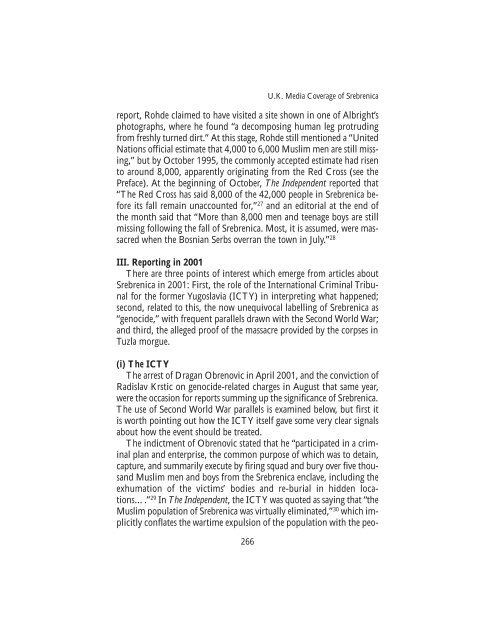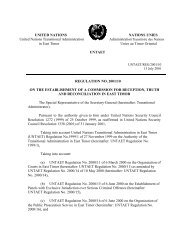The Srebrenica Massacre - Nova Srpska Politicka Misao
The Srebrenica Massacre - Nova Srpska Politicka Misao
The Srebrenica Massacre - Nova Srpska Politicka Misao
Create successful ePaper yourself
Turn your PDF publications into a flip-book with our unique Google optimized e-Paper software.
U.K. Media Coverage of <strong>Srebrenica</strong><br />
report, Rohde claimed to have visited a site shown in one of Albright’s<br />
photographs, where he found “a decomposing human leg protruding<br />
from freshly turned dirt.” At this stage, Rohde still mentioned a “United<br />
Nations official estimate that 4,000 to 6,000 Muslim men are still missing,”<br />
but by October 1995, the commonly accepted estimate had risen<br />
to around 8,000, apparently originating from the Red Cross (see the<br />
Preface). At the beginning of October, <strong>The</strong> Independent reported that<br />
“<strong>The</strong> Red Cross has said 8,000 of the 42,000 people in <strong>Srebrenica</strong> before<br />
its fall remain unaccounted for,” 27 and an editorial at the end of<br />
the month said that “More than 8,000 men and teenage boys are still<br />
missing following the fall of <strong>Srebrenica</strong>. Most, it is assumed, were massacred<br />
when the Bosnian Serbs overran the town in July.” 28<br />
III. Reporting in 2001<br />
<strong>The</strong>re are three points of interest which emerge from articles about<br />
<strong>Srebrenica</strong> in 2001: First, the role of the International Criminal Tribunal<br />
for the former Yugoslavia (ICTY) in interpreting what happened;<br />
second, related to this, the now unequivocal labelling of <strong>Srebrenica</strong> as<br />
“genocide,” with frequent parallels drawn with the Second World War;<br />
and third, the alleged proof of the massacre provided by the corpses in<br />
Tuzla morgue.<br />
(i) <strong>The</strong> ICTY<br />
<strong>The</strong> arrest of Dragan Obrenovic in April 2001, and the conviction of<br />
Radislav Krstic on genocide-related charges in August that same year,<br />
were the occasion for reports summing up the significance of <strong>Srebrenica</strong>.<br />
<strong>The</strong> use of Second World War parallels is examined below, but first it<br />
is worth pointing out how the ICTY itself gave some very clear signals<br />
about how the event should be treated.<br />
<strong>The</strong> indictment of Obrenovic stated that he “participated in a criminal<br />
plan and enterprise, the common purpose of which was to detain,<br />
capture, and summarily execute by firing squad and bury over five thousand<br />
Muslim men and boys from the <strong>Srebrenica</strong> enclave, including the<br />
exhumation of the victims’ bodies and re-burial in hidden locations….”<br />
29 In <strong>The</strong> Independent, the ICTY was quoted as saying that “the<br />
Muslim population of <strong>Srebrenica</strong> was virtually eliminated,” 30 which implicitly<br />
conflates the wartime expulsion of the population with the peo-<br />
266



